oil change OLDSMOBILE SILHOUETTE 1995 Owners Manual
[x] Cancel search | Manufacturer: OLDSMOBILE, Model Year: 1995, Model line: SILHOUETTE, Model: OLDSMOBILE SILHOUETTE 1995Pages: 390, PDF Size: 20.27 MB
Page 274 of 390
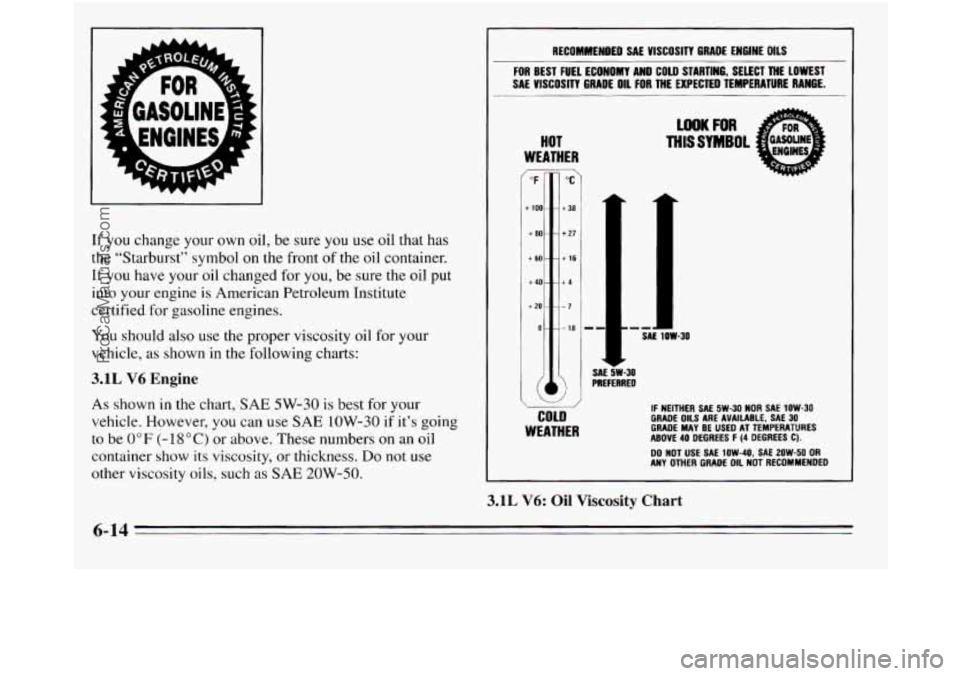
If you change your own oil, be sure you use oil that has
the “Starburst” symbol
on the front of the oil container.
If you have your oil changed for you, be sure the oil put
into your engine
is American Petroleum Institute
certified
for gasoline engines.
You should
also use the proper viscosity oil for your
vehicle, as shown
in the following charts:
3.1L V6 Engine
As shown in the chart, SAE 5W-30 is best for your
vehicle. However, you can
use SAE 1OW-30 if it’s going
to be
0 OF (- 18 O C) or above. These numbers on an oil
container show its viscosity,
or thickness. Do not use
other viscosity oils, such
as SAE 20W-50.
RECOMMENDED SAE VISCOSITY GRADE ENGINE OILS
FOR BEST FUEL ECONOMY AND COUl STARTING, SELECT THE LOWEST
SAE VISCOSITY GRADE OIL FOR THE EXPECTED TEMPERATURE RANGE.
HOT
WEATHER
/OF ‘C‘ -
+ioo- t38 -
+80- +27 -
+60- t 16 -
+ao--+4
+20---7 ~
O---l8
I
i @)
/
COLD
WEATHER
SAE 1OW-30
-30 RED
IF NEITHER SAL 5W-30 NOR SAE 1OW-30 GRADE OILS ARE AVAILABLE, SAE 30 GRADE MAY BE USED AT TEMPERATURES
ABOVE 40 DEGREES F (4 DEGREES C).
ANY OTHER GRADE OIL NOT RECOMMENDED DO NOT USE SAE 1OW-40. SAE 2OW-50 OR
3.1L V6: Oil Viscosity Chart
6-14
ProCarManuals.com
Page 275 of 390
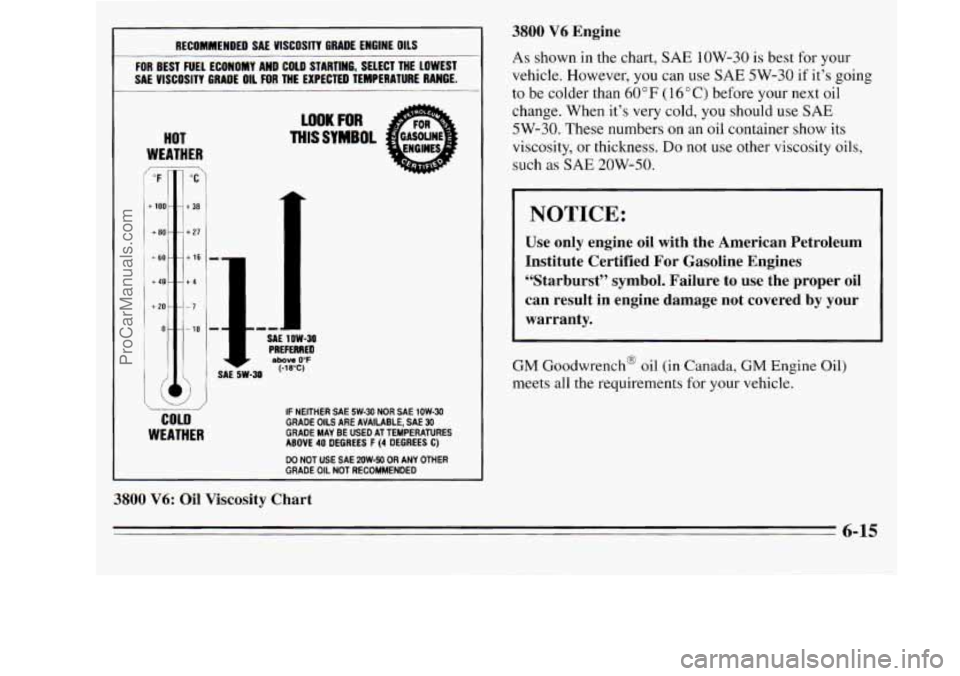
FOR BEST FUEL ECONOMY AND COLD STARIING, SELECT THE LOWEST
SAE VISCOSITY GRADE
OIL FOR THE EXPECTED TEMPERATURE RANGE.
HOT
WEATHER - OF "C
100- - t38
+80- - +27
+60- - +16
+40- - +4
+20- --7
a - --la
COLD
WEATHER
rl
.- e
IF NEITHER SAE SW-30 NOR SAE 1OW-30 GRADE OILS ARE AVAILABLE, SAE 30 GRADE MAY BE USED AT TEMPERATURES ABOVE 40 DEGREES F (4 DEGREES C)
DO NOT USE SAE 2OW-50 OR ANY OTHER
GRADE OIL NOT RECOMMENDED
3800 V6: Oil Viscosity Chart
3800 V6 Engine
As shown in the chart, SAE 1OW-30 is best for your
vehicle. However, you can use
SAE 5W-30 if it's going
to be colder than
60 OF ( 16 O C) before your next oil
change. When it's very cold, you should use SAE
5W-30. These numbers on an oil container show its
viscosity,
or thickness. Do not use other viscosity oils,
such
as SAE 20W-50.
NOTICE:
Use only engine oil with the American Petroleum
Institute Certified For Gasoline Engines
"Starburst" symbol. Failure to use the proper oil
can result in engine damage not covered by your
warranty.
GM Goodwrench@ oil (in Canada, GM Engine Oil)
meets all the requirements for your vehicle.
6-15
ProCarManuals.com
Page 276 of 390
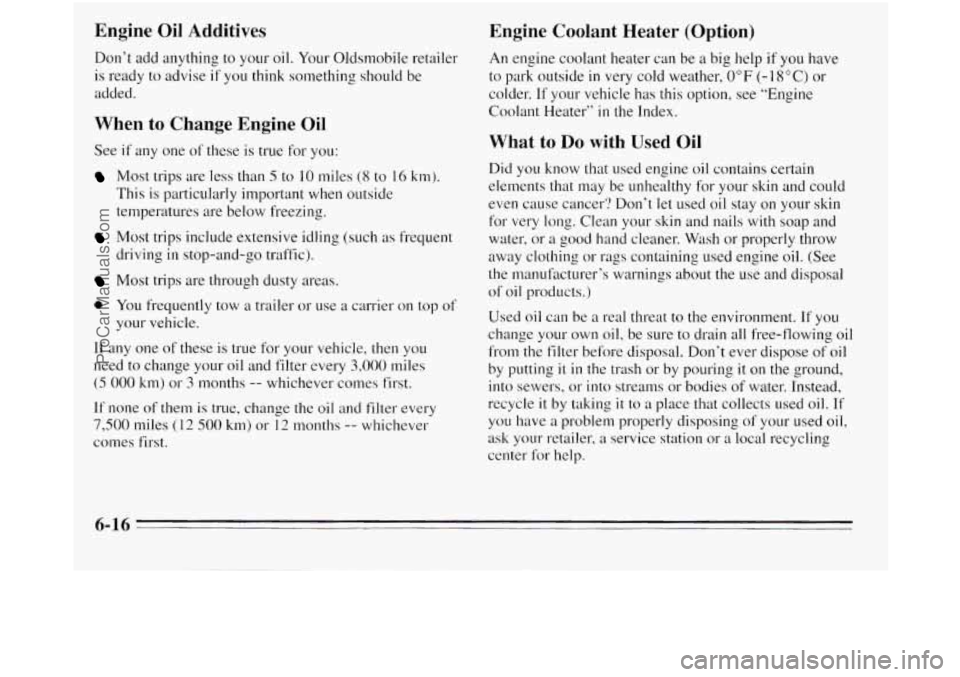
Engine Oil Additives
Don’t add anything to your oil. Your Oldsmobile retailer
is ready
to advise if you think something should be
added.
When to Change Engine Oil
See if any one of these is true for you:
Most trips are less than 5 to 10 miles (8 to 16 krn).
This
is particularly important when outside
temperatures are below freezing.
Most trips include extensive idling (such as frequent
driving
in stop-and-go traffic).
Most trips are through dusty areas.
0 You frequently tow a trailer or use a carrier 011 top of
your vehicle.
If any one
of these is true for your vehicle, then you
need to change your oil and filter every
3,000 miles
(5 000 km) or 3 months -- whichever comes first.
If none
of them is true, change the oil and filter every
7,500 miles (12 500 km) or I2 months -- whichever
comes first.
Engine Coolant Heater (Option)
An engine coolant heater can be a big help if you have
to park outside
in very cold weather, 0°F (- 18OC) or
colder.
If your vehicle has this option, see “Engine
Coolant Heater”
in the Index.
What to Do with Used Oil
Did you know that used engine oil contains certain
elements that may
be unhealthy for your skin and could
even cause cancer? Don’t let used oil stay on your skin
for very long. Clean your skin and nails with soap and
water, or
a good hand cleaner. Wash or properly throw
away clothing or rags containing used engine oil. (See
the manufacturer’s warnings about the use and disposal
of oil products.)
Used oil can be
a real threat to the environment. If you
change your own oil, be sure
to drain all free-flowing oil
from the filter before disposal. Don’t ever dispose of oil
by putting it
in the trash or by pouring it on the ground,
into sewers, or into streams or bodies of water. Instead,
recycle
it by taking it to a place that collects used oil. If
you have a problem properly disposing of your used oil,
ask your retailer, a service station or a local recycling
center for help.
6-16
ProCarManuals.com
Page 279 of 390
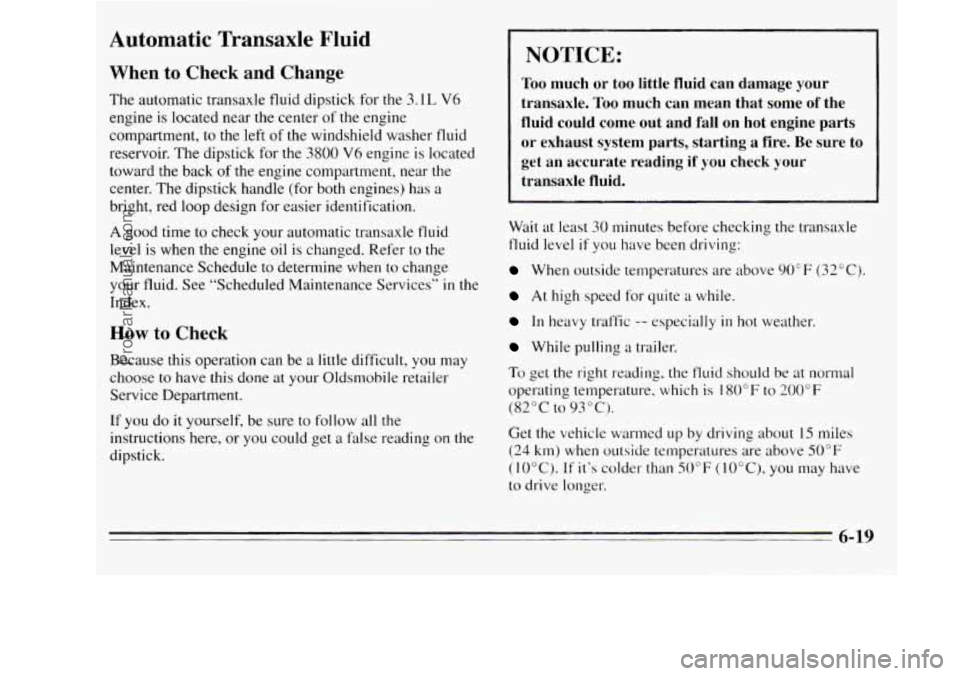
Automatic Transaxle Fluid
When to Check and Change
The automatic transaxle fluid dipstick for the 3.1 L V6
engine is located near the center of the engine
compartment, to the left
of the windshield washer fluid
reservoir. The dipstick for
the 3800 V6 engine is located
toward the back
of the engine Compartment, near the
center. The dipstick handle (for both engines) has
a
bright, red loop design for easier identification.
A good time to check your automatic transaxle fluid
level is when the engine oil is changed. Refer to the
Maintenance Schedule to determine when to change
your fluid. See “Scheduled Maintenance Services”
in the
Index.
How to Check
Because this operation can be a little difficult, you may
choose to have this done at your Oldsmobile retailer
Service Department.
If
you do it yourself, be sure to follow all the
instructions here, or
you could get a false reading on the
dipstick.
NOTICE:
Too much or too little fluid can damage your
transaxle.
Too much can mean that some of the
fluid could come out and fall on hot engine parts
or exhaust system parts, starting a fire. Be sure to
get
an accurate reading if you check your
transaxle fluid.
Wait at least 30 minutes before checking the transaxle
fluid level
if you have been driving:
When outside temperatures are above 90°F (32°C).
At high speed for quite a while.
In heavy traffic -- especially in hot weather.
While pulling a trailer.
To get the right reading, the fluid should be at normal
operating temperature, which is 180°F
to 200°F
(82°C to 93°C).
Get the vehicle warmed up by driving about 15 miles
(24 km) when outside temperatures are above 50°F
(10°C).
If it’s colder than 50°F (lO°C), you may have
to drive longer.
ProCarManuals.com
Page 318 of 390
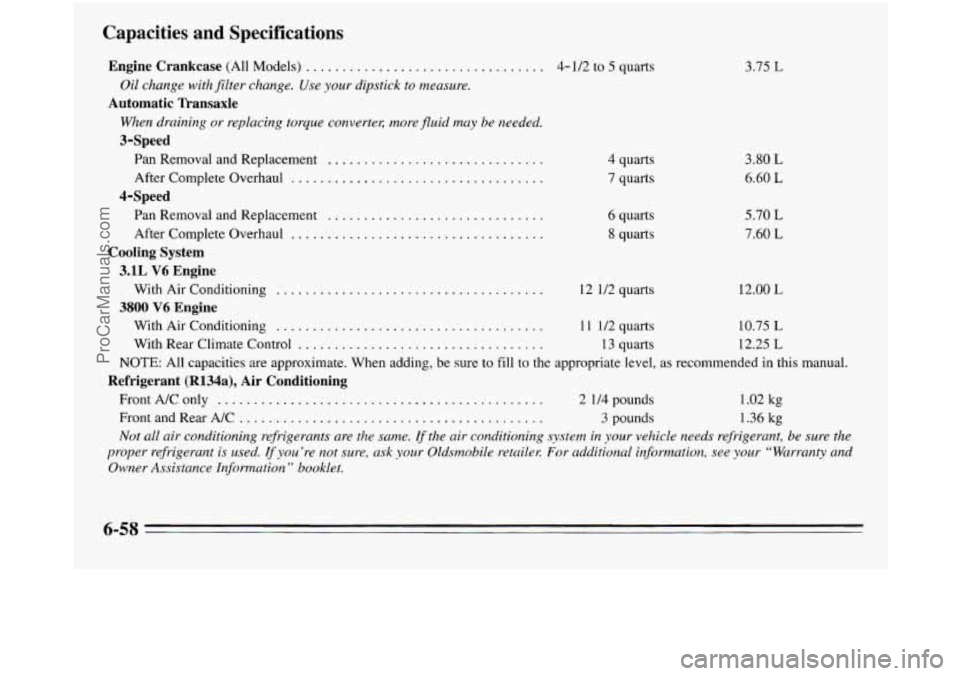
Capacities and Specifications
Engine Crankcase (All Models) ...........................
Oil change with filter change. Use your dipstick to measure.
Automatic Transaxle
When draining or replacing torque convertec more fluid may be needed.
3-Speed
Pan Removal and Replacement ..............................
After Complete Overhaul ...................................
Pan Removal and Replacement ..............................
4-Speed
. . 4-1/2 to 5 marts 3.75 L
4 quarts
7 quarts
6 quarts
8 quarts
12 11’2 quarts 3.80
L
6.60 L
5.70 L
7.60 L
12.00 L
After Complete Overhaul ...................................
Cooling System
3.1L
V6 Engine
3800
V6 Engine
With Air Conditioning .....................................
With Air Conditioning ..................................... 11 1/2 quarts 10.75 L
With Rear Climate Control .................................. 13 quarts 12.25 L
NOTE: All capacities are approximate. When adding, be sure to fill to the appropriate level, as recommended in this manual.
FrontA/Conly
............................................. 2 1/4 pounds 1.02 kg
Front and Rear A/C .......................................... 3 pounds 1.36 kg
Not all air conditioning refrigerants are the same. If the air conditioning s-ystem in your vehicle needs refrigerant, be sure the
proper
refrigerant is used. If you’re not sure, ask your Oldsmobile retailer: For additional information, see your “Warranty and
Owner Assistance Information
” booklet.
Refrigerant (R134a), Air Conditioning
6-58
ProCarManuals.com
Page 323 of 390

1 Section 7 Maintenance Schedule
IMPORTANT.
KEEP ENGINE OIL
AT THE PROPER
LEVEL AND CHANGE AS
RECOMMENDED
This section covers the maintenance required for your
Oldsmobile.
Your vehicle needs these services to retain its
safety, dependability and emission control performance.
I mm
I
Introduction
Your Vehicle and the Environment
Proper vehicle maintenance not only helps to keep your
vehicle
in good working condition, but also helps the
environment. All recommended maintenance procedures
are important. Improper vehicle maintenance
or the
removal
of important components can significantly
affect
the quality of the air we breathe. Improper fluid
levels or even the wrong tire inflation can increase the
level of emissions from your vehicle.
To help protect our
environment, and to help keep your vehicle in good
condition, please maintain your vehicle properly.
ProCarManuals.com
Page 326 of 390
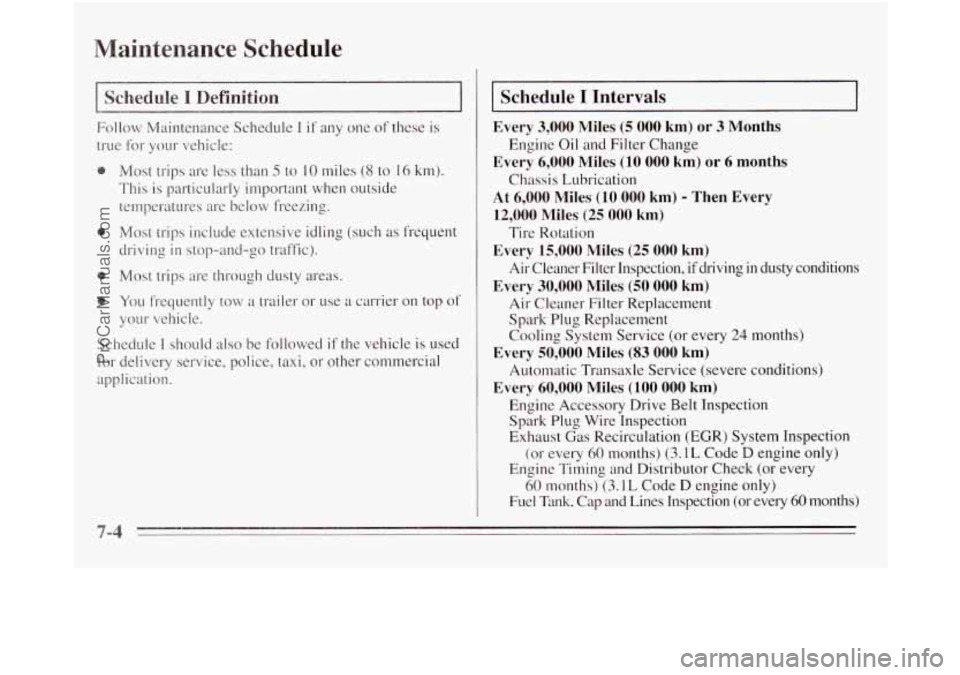
Maintenance Schedule
I Schedule I Definition I
Follow Maintenance Schedule I if any one of these is
true for your vehicle:
0 Most trips are less than 5 to 10 miles (8 to 16 km).
This is particularly important when outside
temperatures are below freezing.
0 Most trips include extensive idling (such as frequent
driving in stop-and-go traffic).
0 Most trips are through dusty areas.
0 You frequently tow a trailer or use a carrier on top 0.f
your vehicle.
Schedule
I should also be followed if the vehicle is used
for delivery service, police, taxi, or other commercial
application.
Schedule I Intervals
Every 3,000 Miles (5 000 km) or 3 Months
Engine Oil and Filter Change
Every 6,000 Miles (10 000 km) or 6 months
Chassis Lubrication
At 6,000 Miles (10 000 km) - Then Every
12,000 Miles (25 000 km)
Tire Rotation
Every 15,000 Miles (25 000 km)
Air Cleaner Filter Inspection, if driving in dusty conditions
Every 30,000 Miles (50 000 km)
Air Cleaner Filter Replacement
Spark Plug Replacement
Cooling System Service (or every
24 months)
Automatic Transaxle Service (severe conditions)
Engine Accessory Drive Belt Inspection
Spark
Plug Wire Inspection
Exhaust
Gas Recirculation (EGR) System Inspection
(or every
60 months) (3.1L Code D engine only)
Engine Timing and Distributor Check (or every
60 months) (3.1 L Code D engine only)
Fuel Tank, Cap and Lines Inspection
(or every 60 months)
Every 50,000 Miles (83 000 km)
Every
60,000 Miles (100 000 km)
7-4
ProCarManuals.com
Page 327 of 390
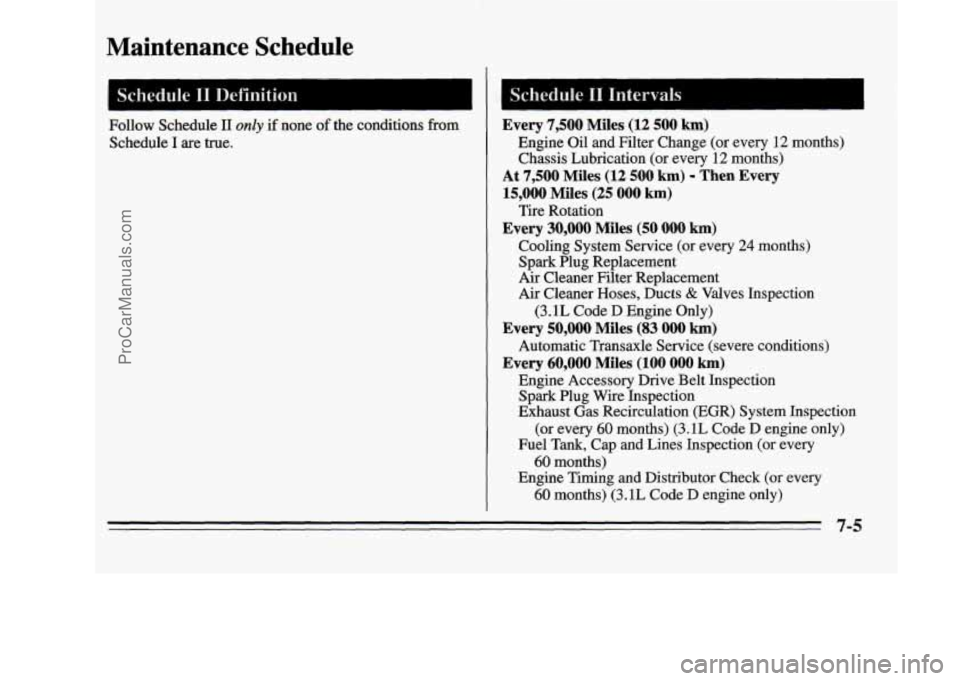
Maintenance Schedule
I Schedule I1 Definition
Follow Schedule I1 only if none of the conditions from
Schedule
I are true.
Every 7,500 Miles (12 500 km)
Engine Oil and Filter Change (or every 12 months)
Chassis Lubrication (or every
12 months)
At 7,500 Miles (12 500 km) - Then Every
15,000 Miles (25 000 km)
Every 30,000 Miles (50 000 km)
Tire Rotation
Cooling System Service (or every
24 months)
Spark Plug Replacement
Air Cleaner Filter Replacement
Air Cleaner Hoses, Ducts
& Valves Inspection
(3.1L Code D Engine Only)
Every 50,000 Miles (83 000 km)
Every 60,000 Miles (100 000 km)
Automatic Transaxle Service (severe conditions)
Engine Accessory Drive Belt Inspection
Spark Plug Wire Inspection
Exhaust Gas Recirculation (EGR) System Inspection
(or every
60 months) (3.1L Code D engine only)
Fuel Tank, Cap and Lines Inspection (or every
60 months)
Engine Timing and Distributor Check (or every
60 months) (3.1L Code D engine only)
7-5
ProCarManuals.com
Page 328 of 390
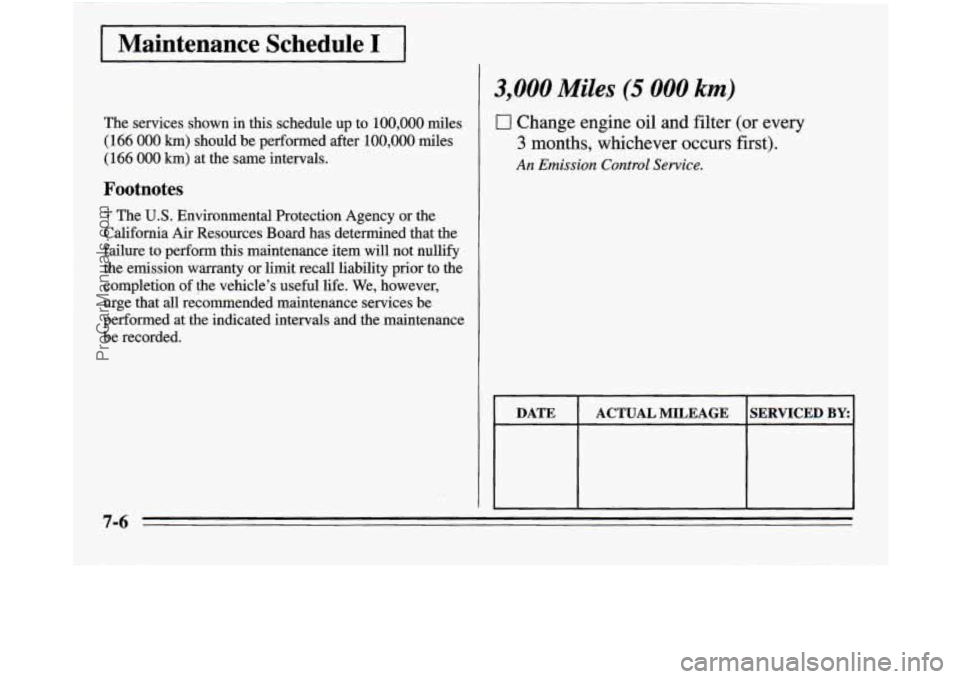
I Maintenance Schedule I I
3,000 Miles (5 000 km)
The services shown in ms. schedule up to 100,000 miles
(166 000 km) should be performed after 100,000 miles
(166 000 km) at the same intervals.
Footnotes
The U.S. Environmental Protection Agency or the
California Air Resources Board has determined that the
failure to perform this maintenance item will not nullify
the emission warranty or limit recall liability prior to the
completion of the vehicle's useful life. We, however,
urge that all recommended maintenance services be
performed at the indicated intervals and the maintenance
be recorded.
0 Change engine oil and filter (or every
3 months, whichever occurs first).
An Emission Control Service.
DATE ACTUAL MILEAGE SERVICED BY: I
7-6
ProCarManuals.com
Page 329 of 390
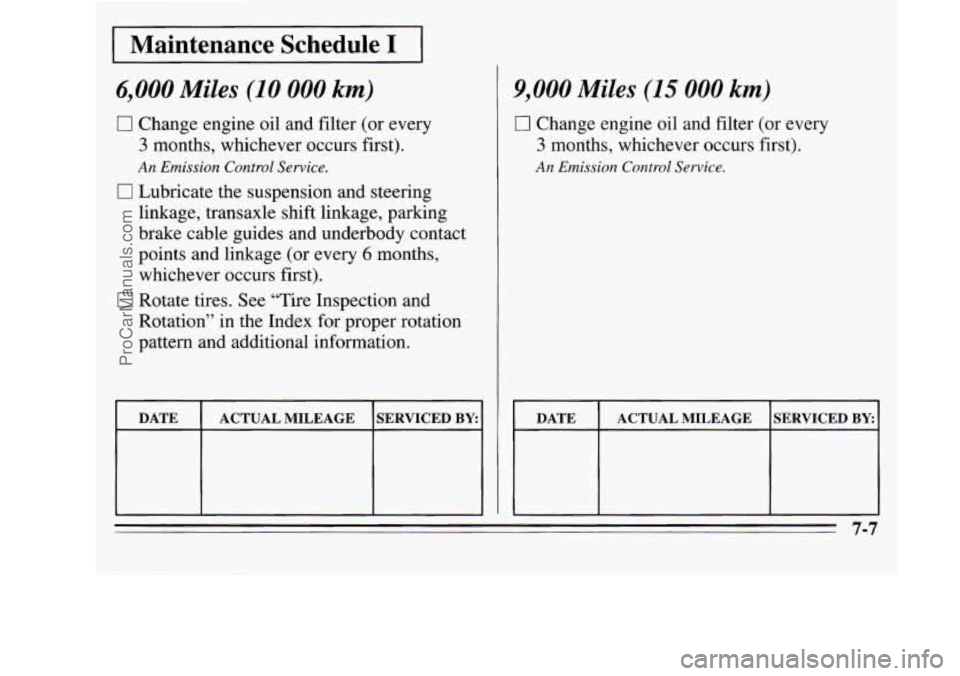
I Maintenance Schedule I I
6,000 Miles (10 000 km)
0 Change engine oil and filter (or every
3 months, whichever occurs first).
An Emission Control Service.
0 Lubricate the suspension and steering
linkage, transaxle shift linkage, parking
brake cable guides and underbody contact
points and linkage (or every
6 months,
whichever occurs first).
0 Rotate tires. See “Tire Inspection and
Rotation” in the Index for proper rotation
pattern and additional information.
DATE
SERVICED BY: ACTUAL MILEAGE
9,000 Miles (15 000 km)
0 Change engine oil and filter (or every
3 months, whichever occurs first).
An Emission Control Service.
I DATE I ACTUAL MILEAGE SERVICED BY I
7-7
ProCarManuals.com